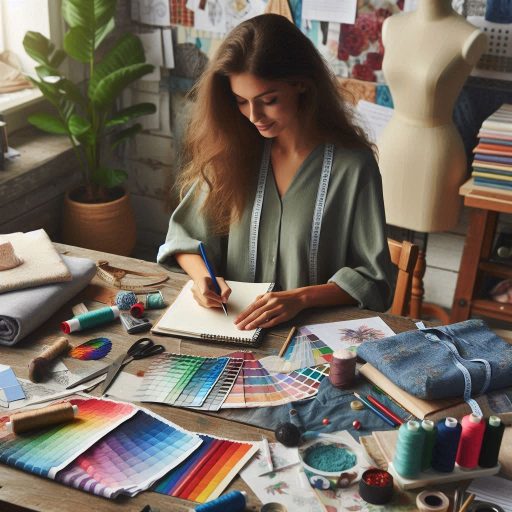Introduction
Presenting furniture designs effectively to clients is crucial in the design process.
A well-executed presentation can set the tone for collaboration and understanding.
Clients often form their initial impressions based on how you present your ideas.
Therefore, clear communication and visual appeal play significant roles in your success.
A strong presentation can influence a client’s decision-making.
When clients see your designs showcased compellingly, they feel more engaged.
A good presentation can build trust and excitement around your vision.
This emotional connection can turn interest into commitment.
Furthermore, well-organized presentations demonstrate professionalism and attention to detail.
They convey that you value the client’s time and opinions.
This attitude fosters a positive atmosphere and encourages open dialogue.
Engaging presentations can help you articulate the functionality and aesthetic appeal of your designs.
In a competitive market, a great presentation distinguishes you from others.
It not only showcases your creativity but also highlights your understanding of client needs.
Ultimately, a powerful presentation can make all the difference in securing a deal.
By investing time in your presentation skills, you increase your chances of success and client satisfaction.
Understand the Client’s Needs
Understanding your client’s needs is crucial for successful furniture design presentations.
It establishes a solid foundation for your project and fosters a strong relationship.
Research the Client’s Preferences and Requirements
Begin your process with thorough research into the client’s preferences and requirements.
This step sets the tone for the entire design journey.
Start by reviewing any preliminary information your client provides.
Look for design styles they favor and the specific types of furniture they need.
Check their social media profiles or portfolios for inspiration.
Websites like Pinterest and Houzz can reveal valuable insights into their tastes.
Analyze images they share to identify recurring themes, colors, and materials.
This initial research helps you tailor your designs to align with their vision.
Ask Questions to Get a Clear Idea of What They Are Looking For
Next, reach out to your client directly.
Engage them in a conversation to understand their needs more comprehensively.
Ask open-ended questions that encourage them to express their thoughts freely.
For example, inquire about their favorite design styles and colors.
Find out what furniture pieces they currently own and love.
This information can guide your design process significantly.
Don’t shy away from asking about their lifestyle.
Understanding how they use their space is vital.
For instance, do they entertain often, or do they prefer a cozy family atmosphere? Ask about the age of their children or pets.
This knowledge helps you select durable materials that withstand wear and tear.
It also allows you to propose functional designs that fit their daily life.
Consider their budget as well.
Inquire about their spending limits to avoid presenting designs that may exceed their financial comfort.
Understanding the budget allows you to suggest creative solutions within their means.
It also shows respect for their financial planning.
Another effective approach is to conduct a site visit.
Visiting their space helps you visualize the environment where your furniture will live.
Pay attention to existing décor, color schemes, and lighting.
Note any architectural features that may influence your designs.
This firsthand experience can inspire ideas that are both practical and aesthetically pleasing.
Throughout this process, actively listen to your client’s feedback.
Take notes during discussions to capture their thoughts accurately.
Reflect their ideas back to them to confirm understanding.
Finally, summarize your findings in a clear document.
This can include their preferences, lifestyle needs, and any constraints.
Present this summary during your design proposal to demonstrate your understanding.
This step reassures your client that you value their input and are committed to delivering designs that resonate with them.
Basically, understanding your client’s needs is foundational to successful furniture design.
Thorough research and effective communication are essential.
By taking these steps, you create a positive experience and deliver designs that exceed expectations.
Create a Professional Portfolio
Creating a professional portfolio is essential for presenting your furniture designs effectively.
A well-structured portfolio showcases your skills and creativity.
Compile High-Quality Images of Your Furniture Designs
Start by compiling high-quality images of your furniture designs.
Ensure that each photo is well-lit and captures the details of your pieces.
Use a professional camera or hire a photographer if necessary.
Display your designs from various angles to give clients a complete view.
Include close-up shots to highlight unique features and craftsmanship.
Include Detailed Descriptions and Specifications for Each Piece
Next, provide detailed descriptions and specifications for each piece.
Describe the materials used in your furniture designs.
Specify dimensions, finishes, and any special features.
This information helps clients understand the quality and functionality of your work.
Consider including the inspiration behind each piece.
Sharing your creative process adds a personal touch to your portfolio.
It allows clients to connect with your designs on a deeper level.
Organize Your Portfolio Logically
Organize your portfolio logically to enhance readability.
Group similar designs together, such as dining tables, chairs, or cabinetry.
This organization helps clients navigate your work easily.
Create a table of contents if your portfolio is extensive.
This feature enables clients to find specific designs quickly.
Choose a Clean and Professional Layout
Choose a clean and professional layout for your portfolio.
Use consistent fonts and colors to create a cohesive look.
Avoid cluttered designs that can distract from your work.
Remember, simplicity often leads to elegance.
Ensure that your portfolio is easy to read, with ample white space between images and text.
Incorporate Client Testimonials
Consider incorporating client testimonials into your portfolio.
Positive feedback reinforces your credibility and expertise.
Testimonials provide social proof of your design capabilities.
They can also highlight your professionalism and ability to meet client needs.
If you have worked with reputable clients, mention them as well.
This association can enhance your portfolio’s appeal.
Tailor Your Selections to Your Target Audience
Think about your target audience when compiling your portfolio.
Tailor your selections to showcase styles and designs that appeal to them.
For instance, if you focus on modern furniture, emphasize contemporary designs.
On the other hand, if your work includes rustic pieces, showcase that style prominently.
Make Your Portfolio Accessible
Finally, make your portfolio accessible to potential clients.
Consider creating a digital version to share online.
A website or PDF can reach a broader audience.
Ensure that the digital format maintains high image quality.
Optimize loading times to enhance user experience.
By creating a professional portfolio with high-quality images and detailed descriptions, you elevate your furniture designs.
A well-presented portfolio showcases your skills and attracts clients.
It is your opportunity to make a lasting impression in the competitive furniture design market.
Read: Building a Portfolio for Costume Design
Utilize 3D Visualization Tools
In today’s design landscape, presenting furniture designs effectively is crucial for client satisfaction.
One powerful way to achieve this is by utilizing 3D visualization tools.
Software like SketchUp or AutoCAD can help you create realistic renderings of your designs.
These tools offer dynamic features that allow you to showcase your ideas with precision and clarity.
Use Software Like SketchUp or AutoCAD to Create Realistic Renderings of Your Designs
3D visualization tools allow you to transform your sketches into three-dimensional models.
Clients often find it challenging to visualize flat designs.
By providing them with realistic renderings, you bridge this gap.
The visual representation helps clients see how your designs will fit into their spaces.
It also aids in conveying the intended aesthetics and functionality.
Using SketchUp, you can create detailed models of your furniture.
This software is user-friendly and versatile, making it ideal for designers at any skill level.
You can manipulate shapes, colors, and materials to reflect your vision accurately.
Furthermore, SketchUp offers a library of pre-made components, saving you time during the design process.
AutoCAD is another excellent tool for producing high-quality visualizations.
It is widely recognized in the industry for its precision and robustness.
With AutoCAD, you can create detailed floor plans and elevations.
This capability allows clients to see how the furniture will interact with the surrounding space.
It is particularly beneficial for commercial projects where space optimization is crucial.
Show Clients Different Angles and Perspectives to Give Them a Better Understanding of the Final Product
When presenting your designs, showing clients different angles and perspectives is vital.
3D visualization tools allow you to rotate models and view them from various viewpoints.
This feature provides clients with a comprehensive understanding of the final product.
They can see how light interacts with your designs, enhancing their appeal.
It also helps them grasp the scale and proportion of the furniture.
Incorporating animations into your presentations can further engage clients.
Tools like SketchUp enable you to create walkthroughs, showcasing how the furniture fits into a space.
This immersive experience captures clients’ attention and sparks their imagination.
They can envision how your furniture will look and function in real life.
Additionally, consider using virtual reality (VR) technology for an even more interactive experience.
Clients can wear VR headsets and explore your designs in a virtual environment.
This level of engagement fosters a stronger emotional connection to your work.
In general, utilizing 3D visualization tools is essential for presenting furniture designs effectively.
Software like SketchUp and AutoCAD allows you to create realistic renderings.
By showcasing different angles and incorporating animations, you enhance client understanding and satisfaction.
Ultimately, these tools can elevate your presentations and strengthen your client relationships.
Read: Networking Events for Costume Designers
Prepare a Mock-Up or Prototype
Creating a mock-up or prototype is crucial for presenting your furniture designs to clients.
This tangible representation helps clients visualize your concepts.
A physical model allows them to interact with the design in real time.
It transforms abstract ideas into concrete objects that can be evaluated.
Consider Creating a Physical Model
Start by selecting materials that reflect the final product.
Use wood, foam, or cardboard to create your prototype.
The goal is to mimic the actual furniture as closely as possible.
This step enhances your credibility as a designer.
It shows clients your attention to detail and commitment to quality.
Allow Clients to Interact with the Mock-Up
When presenting the mock-up, emphasize its features and benefits.
Explain how each element contributes to the overall functionality.
Clients appreciate understanding the reasoning behind your design choices.
Highlight the design’s ergonomics and usability during your presentation.
Encourage clients to interact with the mock-up.
Let them sit on a chair or open a drawer.
This hands-on experience helps them gauge size and shape.
It also allows them to assess comfort and functionality.
Engaging with the prototype gives clients a realistic feel for the design.
This interaction can lead to valuable feedback that shapes the final product.
Transform Your Career Today
Unlock a personalized career strategy that drives real results. Get tailored advice and a roadmap designed just for you.
Start NowEngage Clients with Specific Questions
Ask clients specific questions while they engage with the model.
Inquire about their thoughts on the comfort of a chair or the height of a table.
This feedback provides insight into their preferences.
It also demonstrates that you value their opinions.
Incorporating their feedback can lead to stronger client relationships.
Consider Digital Mock-Ups as a Supplement
In addition to physical models, consider digital mock-ups.
Use 3D rendering software to create realistic images.
These can complement your physical prototypes.
Digital mock-ups are great for clients who may be distant or unable to visit in person.
They can still experience your design through virtual representations.
Presenting both physical and digital prototypes showcases your versatility.
It highlights your ability to adapt to client needs.
Some clients may prefer one method over the other.
Being prepared with both options allows for a more personalized experience.
Ensure the Mock-Up Reflects the Final Design
Finally, ensure the mock-up reflects the final design.
Pay attention to color, texture, and finish.
This fidelity assures clients they will receive a high-quality product.
It also builds trust and confidence in your design capabilities.
Essentially, preparing a mock-up or prototype is vital in presenting your furniture designs.
It offers clients a tangible representation of your ideas.
By allowing interaction, you enhance their understanding and connection to the design.
Engaging clients through prototypes fosters collaboration and can lead to successful outcomes.
Read: Breaking Down Iconic Movie Costumes

Practice Your Presentation
Practicing your presentation is vital for a successful client meeting.
Rehearse your pitch until you feel confident and comfortable.
Familiarity with your material will help you communicate effectively.
Prepare for potential questions your clients might ask.
Think about the unique features of your designs and how they benefit clients.
Highlight these aspects during your presentation to make a lasting impression.
Structure Your Presentation
Start by outlining your presentation structure.
Divide it into sections that clearly convey your message.
Each section should focus on different elements of your design.
This structured approach will keep your audience engaged and interested.
Use visuals to support your pitch, such as sketches, mood boards, or 3D models.
Visuals can help clients visualize your ideas more clearly.
Rehearse and Get Feedback
When rehearsing, practice in front of a mirror or record yourself.
This allows you to see your body language and hear your tone.
Make adjustments as needed to improve your delivery.
Pay attention to your pace and clarity.
Speaking too quickly can make it hard for clients to follow.
Slow down and emphasize key points.
Invite friends or colleagues to act as your audience.
Their feedback can provide valuable insights.
Ask them to challenge you with questions about your designs.
This practice will help you think on your feet.
It will also increase your confidence in addressing client concerns.
Focus on Unique Features
During your presentation, focus on the unique features of your furniture designs.
Explain how these features solve problems or enhance clients’ lives.
Discuss the materials you use and their benefits, such as durability and sustainability.
Highlight any innovative techniques that set your designs apart from competitors.
Articulate the Benefits
Make sure to clearly articulate the benefits of your designs.
Clients want to understand how your furniture will improve their spaces.
Discuss how your designs contribute to functionality, aesthetics, and comfort.
Use real-life examples to illustrate these points.
Show how your furniture can transform a room or fit seamlessly into a client’s lifestyle.
Engage Your Clients
Remember, your goal is to create excitement about your designs.
Engage your clients by asking for their thoughts throughout the presentation.
Encourage them to share their preferences and ideas.
This interaction will make your presentation feel more like a conversation.
Summarize and Invite Questions
End your presentation by summarizing the key points.
Reinforce the unique features and benefits of your designs.
Invite questions and provide thoughtful answers.
Thank your clients for their time and express your enthusiasm for the opportunity to work with them.
With thorough preparation and a focus on your designs’ unique attributes, you can leave a lasting impression on your clients.
to your design vision and showcase your passion for furniture design during the presentation.
When presenting your furniture designs to clients, it’s important to showcase your craftsmanship in order to impress and build trust.
Here are some key points to keep in mind:
Read: Historic Costume Design Inspirations
Showcase Your Craftsmanship
When presenting your furniture designs to clients, showcasing your craftsmanship is essential.
Clients want assurance that their investment is worth it.
Emphasizing the quality of materials and construction techniques can set your designs apart.
The Quality of Materials and Construction Techniques
Start by highlighting the materials you use.
Discuss their origin and durability.
Clients appreciate knowing that you source high-quality woods, metals, and fabrics.
Explain how these materials contribute to the longevity of your pieces.
For example, you might use sustainably sourced hardwood that resists wear over time.
This not only showcases your commitment to sustainability but also assures clients of their investment’s durability.
Next, delve into your construction techniques.
Share the methods that distinguish your work.
Explain the benefits of joinery techniques, such as dovetail joints or mortise-and-tenon.
These methods enhance the strength and aesthetics of your furniture.
Clients will appreciate understanding the extra effort you put into each piece.
Include visual aids in your presentation.
High-quality photographs can highlight the craftsmanship of your furniture.
Capture the details of joints, finishes, and textures.
Use close-ups to showcase the beauty and quality of the materials.
Clients will be drawn to the intricate details that reflect your skills.
Share Testimonials or Reviews from Previous Clients
Another effective way to build credibility is through client testimonials.
Positive feedback can significantly impact a potential buyer’s decision.
Share stories from satisfied clients who love your work.
Ask past customers if they would provide written reviews or video testimonials.
Highlight their experiences and how your furniture has improved their spaces.
Incorporate these testimonials into your presentations.
Display them on your website or in promotional materials.
When potential clients see authentic feedback from previous customers, they feel more confident in your abilities.
Consider creating a dedicated section on your website for reviews.
This transparency showcases your commitment to quality and customer satisfaction.
You can also use case studies to demonstrate your craftsmanship.
Detail specific projects where your skills made a significant impact.
Explain the challenges you faced and how you overcame them.
Show before-and-after photos to illustrate the transformation.
This not only showcases your craftsmanship but also tells a story about your process.
In a nutshell, emphasizing your craftsmanship is key to presenting your furniture designs effectively.
Highlight the quality of materials and construction techniques used in your pieces.
Share testimonials and case studies to build credibility and trust.
When clients see your commitment to quality, they will feel more confident in choosing your furniture for their homes.
Member to focus on what sets your designs apart and why they are worth investing in.
Offer Customization Options
Presenting furniture designs to clients requires a thoughtful approach.
Offering customization options is a crucial part of this process.
It empowers clients and allows them to express their unique tastes.
When clients can personalize certain aspects of a design, they feel more connected to the final product.
Give Clients the Opportunity to Personalize Certain Aspects of the Design
Start by discussing customization during your initial meeting.
Ask clients about their preferences and style.
This conversation lays the foundation for a collaborative relationship.
It shows that you value their input and want to meet their needs.
Next, prepare a selection of samples to showcase.
Provide various finishes, fabrics, and hardware choices.
This visual aid helps clients imagine how different elements can come together.
It simplifies the decision-making process.
When clients see options in person, they better understand the potential of your designs.
Encourage clients to mix and match options.
This flexibility fosters creativity and innovation in the design process.
It also demonstrates your willingness to work with their ideas.
For instance, clients might choose a traditional fabric with modern hardware.
This blend of styles can lead to exciting and unique results.
Show Them Samples of Different Finishes, Fabrics, or Hardware Choices
Display fabric swatches prominently.
Include various textures and colors to appeal to different tastes.
If you offer upholstery, let clients touch and feel the materials.
This tactile experience enhances their connection to the design.
Clients often appreciate exploring textures and seeing how they complement your furniture.
In addition to fabric, present a range of finishes.
Include wood stains, paint colors, and metal finishes.
This variety allows clients to envision how the piece fits into their home.
Some clients may prefer a rustic wood finish, while others might want a sleek, modern look.
By offering choices, you cater to diverse preferences.
Don’t forget about hardware options.
Show clients different knobs, handles, and hinges.
These small details can significantly influence the overall look of a piece.
Clients often enjoy selecting hardware that reflects their personal style.
It gives them a sense of ownership over the final design.
Be sure to document all customization requests.
Create a detailed list of choices and preferences discussed.
This record ensures that you and your client are on the same page.
It also helps prevent misunderstandings later in the project.
Finally, keep the lines of communication open.
Regularly check in with clients to confirm their choices.
This proactive approach builds trust and ensures satisfaction.
By offering customization options, you not only enhance your designs but also create a lasting relationship with your clients.
Showcase Your Business Today
Reach thousands of readers actively exploring professional services. Publish your business profile and grow your audience now.
Publish NowFollow Up After the Presentation
Following up after your furniture design presentation is crucial for maintaining a professional relationship with your clients.
Send a Thank You Email Expressing Your Gratitude for Their Time
Start by sending a thank you email to express your gratitude for their time.
Acknowledge the effort they made to meet with you and show appreciation for their interest in your designs.
This gesture not only reflects professionalism but also reinforces your commitment to client satisfaction.
In your thank you email, be sure to personalize your message.
Reference specific topics discussed during the presentation.
Mention any design features that seemed to resonate with them.
This approach shows that you were engaged and attentive during your meeting.
It also creates a sense of connection, making clients feel valued and understood.
Offer to Address Any Further Questions or Concerns They May Have
Next, offer to address any further questions or concerns they may have.
Encourage them to reach out if they need clarification on any aspect of your designs.
This invitation shows that you are open to dialogue and willing to assist.
Providing this support can alleviate any uncertainties they may have after the presentation.
In your email, consider including a brief recap of the key points from your presentation.
Summarize the highlights of your furniture designs.
Reiterate how these designs meet their needs and align with their vision.
This recap serves as a reminder of your ideas and reinforces their interest.
You can also attach additional materials to support your designs.
Include high-quality images or sketches of your furniture pieces.
If you discussed specific materials or finishes, consider adding samples.
Providing this extra information enhances their understanding and keeps your designs fresh in their minds.
Moreover, suggest scheduling a follow-up meeting.
A brief check-in can help gauge their interest and address any further questions.
This proactive approach demonstrates your dedication to the project.
It allows you to build on the momentum from the initial presentation.
Timing is Key When Sending Your Follow-Up Email
Timing is key when sending your follow-up email.
Aim to send it within 24 hours of your presentation.
This promptness shows respect for their time and keeps the conversation going.
Clients appreciate when you prioritize their needs, enhancing their overall experience.
Maintain a Professional Yet Friendly Tone
Finally, maintain a professional yet friendly tone throughout your communication.
Your follow-up should reflect your personal style while remaining business-like.
A warm, genuine email fosters goodwill and helps establish a lasting relationship.
To sum it all up, following up after your presentation is vital.
Send a thank you email, recap key points, and invite further questions.
By doing so, you strengthen your client relationships and increase the likelihood of successful project outcomes.
Conclusion
In this blog, we explored effective strategies for presenting furniture designs to clients.
First, we highlighted the importance of understanding your audience.
Tailoring your presentation to meet their specific needs will create a stronger connection.
Next, we discussed the significance of clear visuals.
High-quality images and samples can enhance your message and capture attention.
We also emphasized storytelling in your presentations.
Sharing the inspiration behind your designs makes them relatable and memorable.
Engaging clients through interactive elements can further enhance their experience.
Asking for feedback during the presentation encourages collaboration and shows you value their input.
Additionally, we noted the importance of practicing your delivery.
A confident presentation instills trust and showcases your professionalism.
Finally, follow up with clients after your meeting.
This reinforces your commitment and allows you to address any lingering questions.
By implementing these strategies, you can elevate your furniture design presentations.
Focus on understanding your clients, using effective visuals, and engaging storytelling.
These approaches will not only impress your clients but also increase your chances of securing their business.
Take the time to refine your presentation skills and see the positive impact it can have on your design career.
Start applying these tips today!preferences and needs, and always be open to feedback and suggestions. Good luck!
[E-Books for Sale]
The Big Book of 500 High-Paying Jobs in America: Unlock Your Earning Potential
$19.99 • 500 High-Paying Jobs • 330 pages
Explore 500 high-paying jobs in America and learn how to boost your career, earn more, and achieve success!
See All 500 High-Paying Jobs of this E-Book
1001 Professions Without a Degree: High-Paying American Jobs You Can Start Now
$19.99 • 1001 Professions Without a Degree • 174 pages
Discover 1001 high-paying jobs without a degree! Unlock career tips, skills, and success strategies for just $19.99!




